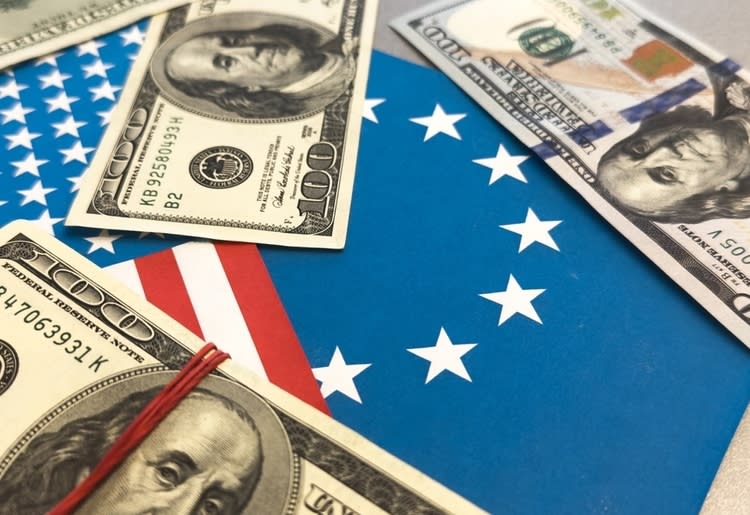
President Donald Trump has made tariffs a cornerstone of his economic strategy, calling them "the most beautiful word in the dictionary." But what's really behind his aggressive tariff approach?
Tariffs aren't just an economic tool for Trump—they're a multifaceted strategy aimed at reshaping international trade relationships and addressing what he sees as critical national challenges.
This article explains the complex motivations behind Trump's trade policies and their potential impact on American businesses and consumers.
» Concerned about tariff impacts? Check out our best tax relief services to protect your money.
Key Insights
- Trump's tariffs aim to boost US manufacturing and jobs by making imports costlier.
- Tariffs serve as leverage for diplomacy, security, drug control, and potential revenue.
- The approach challenges trade norms, focusing on reciprocity and national security.
- Economists warn of higher prices and recession risks despite potential industry benefits.

The Multiple Motivations Behind Trump's Tariff Strategy
Economic Revitalization and Job Creation
Trump's tariff approach is fundamentally about reinvigorating American manufacturing. His key objectives include:
Bringing manufacturing back to the US: Trump aims to make domestic production more attractive by imposing taxes on imported goods.
Protecting American workers: Tariffs are designed to create a more level playing field for US manufacturers.
Incentivizing domestic production: Companies would face higher costs for imported goods, potentially encouraging them to manufacture within the United States.
The strategy is rooted in a deep-seated belief that global trade has disadvantaged American manufacturers and workers. Trump argues that by making foreign goods more expensive, he can force companies to reconsider their manufacturing locations.
This approach challenges the trend of sending jobs abroad, which has moved many American manufacturing positions overseas in search of cheaper production costs. Over time, this shift has opened doors for other countries to produce low-cost goods.
Border Security and Drug Control
Tariffs are also being used as a tool for addressing national security concerns:
Fighting illegal immigration: Tariffs have been directly tied to border enforcement goals.
Addressing the fentanyl crisis: Countries like Mexico and Canada face pressure through trade measures to help stop drug trafficking.
Diplomatic leverage: America's position as a major buyer gives it unique negotiating power.
This marks a significant shift in trade policy thinking. By connecting trade policies directly to national security and drug control issues, Trump is using tariffs as a multipronged diplomatic weapon.
For instance, the administration has argued that tariffs on Mexico and Canada are part of a broader strategy to combat the flow of illegal drugs and migrants.
Revenue Generation and Budget Balancing
Trump sees tariffs as a potential financial windfall:
Alternative revenue stream: Tariffs could generate significant income for the federal government and could be an alternative to taxes and debt.
Potential budget offset: The administration estimates tariffs could bring in around $120 billion annually.
Reducing dependence on income taxes: Trump has suggested tariffs could eventually reduce the need for traditional taxation.
» Drowning in tax debt? Learn how to choose the best tax relief service.
Potential Economic Consequences
Economists remain skeptical about the comprehensive benefits of Trump's tariff strategy:
Price increases: Tariffs typically result in higher consumer prices.
Economic uncertainty: Businesses may struggle with unpredictable trade policies.
Potential recession risks: Some experts warn that aggressive tariffs could trigger an economic downturn.
The government can generate revenue while protecting domestic industries by imposing taxes on imported goods. The Committee for a Responsible Federal Budget estimates that Trump's tariffs on China, Mexico, and Canada could generate approximately $1.3 trillion over a decade.
» Confused by the new tax changes? Learn how Trump's tax plans can affect you in 2025.
The Broader Global Context
Trump's approach breaks from traditional trade policies in three key ways:
- Matching other countries: Trump believes in "reciprocal taxation" - if another country puts a 10% tariff on American products, America should charge the same on theirs. For example, when the EU taxed American cars 10%, Trump proposed the same tax on European vehicles.
- Protecting national security: Trump argues some industries are vital for defense. His 2018 steel and aluminum tariffs were designed to ensure America can produce these materials domestically for military needs.
- Gaining negotiation power: Trump uses tariffs as bargaining chips. During trade talks with China, he raised and lowered tariffs strategically to win concessions.
The impact extends far beyond simple taxation. Historical data suggests that previous tariff implementations have led to complex economic ripple effects.
For example, tariffs on steel and aluminum in 2018 increased domestic prices for these materials by 2.4% and 1.6%, respectively, according to the US International Trade Commission.
Protecting Your Finances During Tariff Shifts
As Trump's tariff strategy reshapes trade relationships, everyday Americans may feel the effects. Here's how to navigate these economic changes:
- Identify vulnerable sectors: Focus on industries specifically targeted by Trump's tariffs, such as imported steel, aluminum, electronics, and certain consumer goods from China and Europe.
- Anticipate price shifts: Trump's "reciprocal taxation" approach means products from countries with high tariffs on American goods may see price increases. Research these trade relationships before major purchases.
- Consider American manufacturing: As tariffs aim to boost domestic production, American-made alternatives may become more competitively priced against previously cheaper imports.
- Adjust investments based on tariff targets: Review your portfolio with Trump's national security priorities in mind, potentially favoring domestic manufacturing and resource sectors that benefit from import protections.
- Consult a financial advisor: Work with a professional who understands how Trump's specific tariff strategy might affect your personal or business finances.
- Monitor trade negotiations: Trump uses tariffs as negotiation leverage, so prices may fluctuate as deals are made. Stay informed about developing trade agreements that could affect consumer prices.
- Plan for potential industry shifts: If your industry is significantly affected by the "America First" trade approach, be prepared for employment or supply chain changes.
Conclusion
While Trump's tariff strategy is complex and controversial, it reflects a fundamental belief in using economic tools to reshape international trade dynamics. The long-term effectiveness remains to be seen, with potential benefits and risks still unfolding.
Ultimately, these policies will continue to impact American businesses, consumers, and the global economic landscape. Staying informed and adaptable will be key to navigating these challenging economic waters.
» Want to protect your financial future? Learn expert tax planning strategies today.



